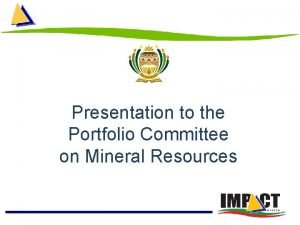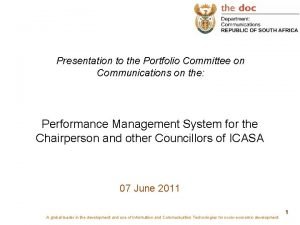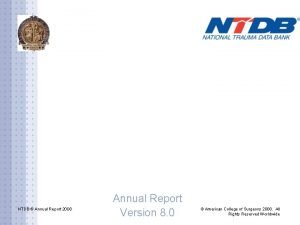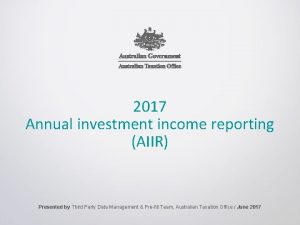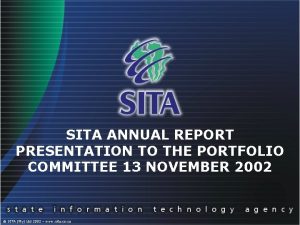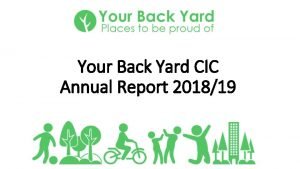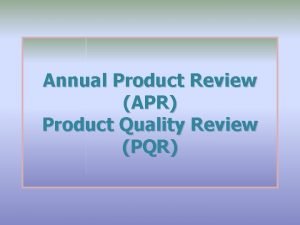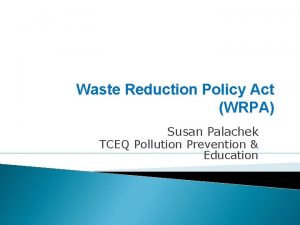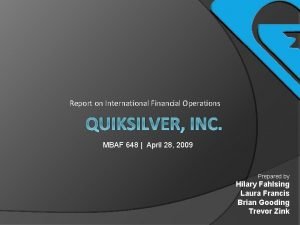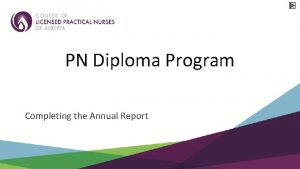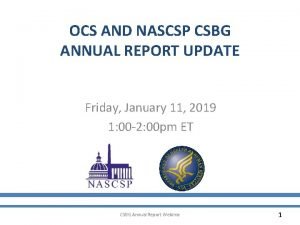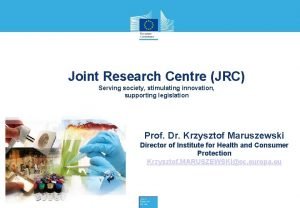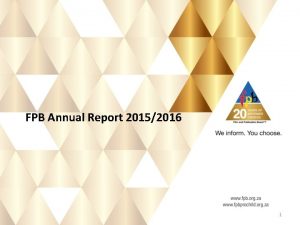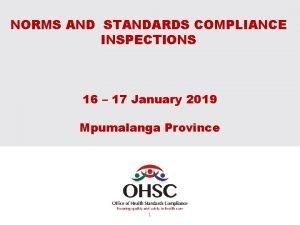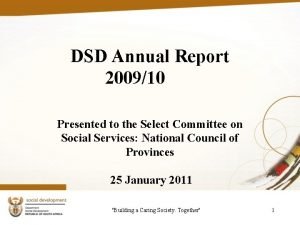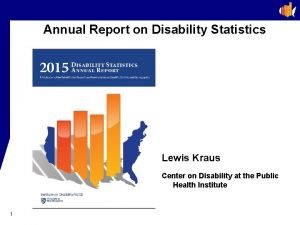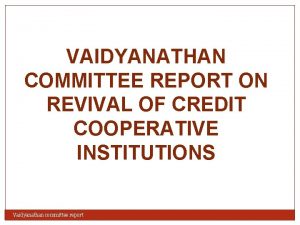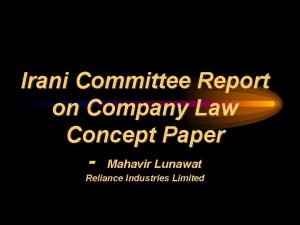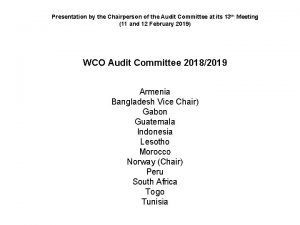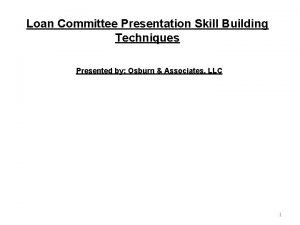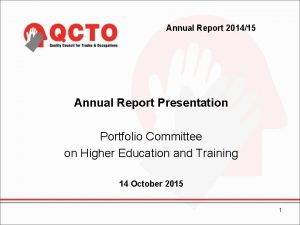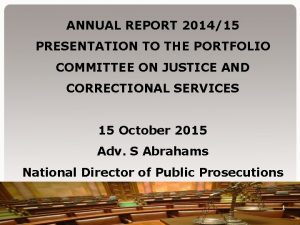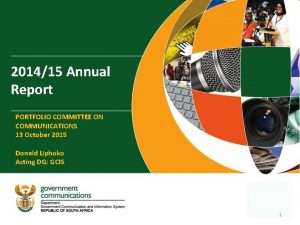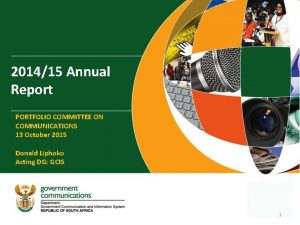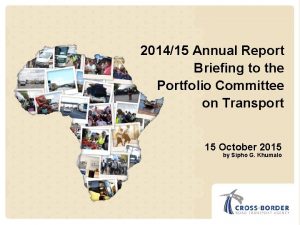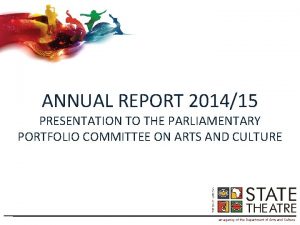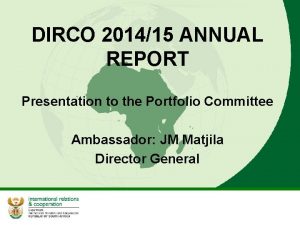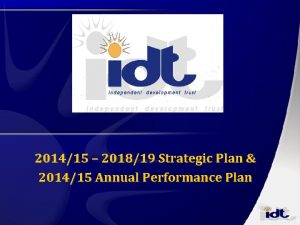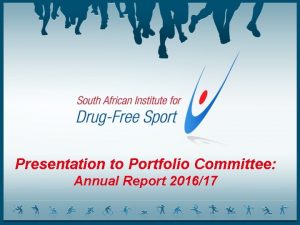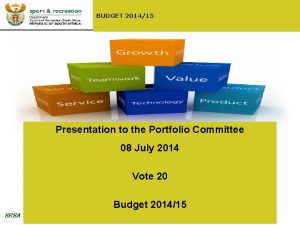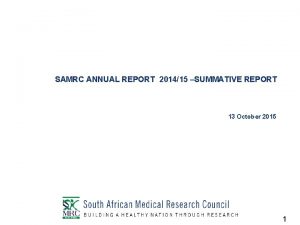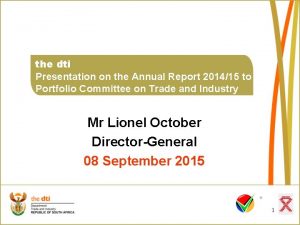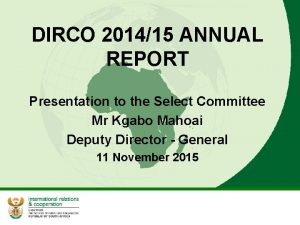201415 Annual Report Presentation to the Portfolio Committee

















![Overview of Corporate Performance; 2014/15 0% - 50% (Ineffective) 4% [CATEGORY NAME] [PERCENTAGE] 86% Overview of Corporate Performance; 2014/15 0% - 50% (Ineffective) 4% [CATEGORY NAME] [PERCENTAGE] 86%](https://slidetodoc.com/presentation_image/adbfc4e87d544860805b1ade54187c27/image-18.jpg)



































- Slides: 53

2014/15 Annual Report Presentation to the Portfolio Committee for Public Works by the IDT Board of Trustees Parliament of the Republic of South Africa Tuesday, 16 February 2016

Presentation Overview 1. Contextual Background 2. Performance Highlights 3. Governance 4. Human Resource Management 5. Financial Information 6. Conclusion

1. Contextual Background

Introduction The IDT has been in transition for the past 5 years. The transformation process aimed at maximising IDT’s contribution to the country’s development effort. Iterative engagements with key stakeholders point to the need for the IDT to be a critical vehicle that supports government to deliver social infrastructure across the country. The IDT has experienced portfolio growth of approximately 500 % within the last 7 years, accompanied by operational challenges, chief being financial viability. IDT’s impressive contribution to national development efforts and governance record has been marred by the disclaimed AG opinion on its report for the 2014/15 financial year.

Basis for the Disclaimed Audit After 11 consecutive unqualified opinions, spanning 2002/03 to 2012/13, the IDT received a qualified audit opinion for the 2013/14 financial year followed by a disclaimed opinion in 2014/15. Basis of the disclaimer for 2014/15: 1. Lack of sufficient appropriate audit evidence regarding balances relating to programme reserves and liabilities; 2. Lack of sufficient appropriate audit evidence regarding revenue and trade and other receivables; 3. Lack of sufficient appropriate audit evidence regarding impairment provision for trade and other receivables; and 4. The material misstatement in financial statements amounting to R 7, 3 million in expenditure; other income; property, plant and equipment; and other trade and other payables.

Root Causes of the Disclaimed Audit Systems: Inadequate investment in systems and business processes; Human resources: Inadequate human resource capacity in critical areas arising from staff recruitment moratorium induced by the transformation process; Portfolio growth: Exponential portfolio growth outstripping investments in systems and human resources; Financial constraints: Change in funding model characterised by teething challenges relating to service billing, exacerbating the solvency risks. Accounting standards: The A-G instituted in the 2014/15 audit period, stringent compliance with accounting standards relating to disclosure of programme funds managed on behalf of clients. Internal controls: Inadequate follow through on implementation of internal controls resulting from inadequate capacity in financial management.

Organisational Renewal The Board has initiated a 2 -pronged approach to remedy the situation: 1. Leadership review and management accountability 2. The Turnaround Strategy and Plan; and 3. A comprehensive audit action plan. Paramount to the Board’s plan is: 1. The attainment of an unqualified report in the 2015/16 financial years; 2. Holding officials accountable; 3. Building the IDT into a leading public sector social infrastructure programme implementation and management agency; and 4. Ensuring maximum returns to the Shareholder.

IDT Turnaround Strategy The objectives of the IDT Turnaround Strategy, covering the period 1 April 2015 to 31 March 2020, are to: 1. Strategically position the IDT as a premier social infrastructure programme delivery management entity; 2. Regain confidence of the Shareholder, client departments and stakeholders; 3. Ensuring financial sustainability, prudent financial management and accountability for the IDT as well as for client funds; 4. Attract and retain appropriately qualified, committed and motivated personnel; 5. Develop and utilise effective and efficient business systems and processes to successfully implement programmes that contribute to the improvements in the quality of life of communities.

IDT Turnaround Strategy Pillars The following pillars provide the basis for the Turnaround: 1. Financial viability improvements; 2. Organisational integrity, governance, accountability and compliance; 3. Service delivery improvements and Innovation; 4. Organisational reconfiguration, professionalisation and image building. Three interlinked timelines are utilised: 1. Short Term: 1 April 2015 to 31 March 2016 2. Medium Term: 1 April 2015 to 31 March 2018 3. Long Term: 1 April 2015 to 31 March 2020

IDT Turnaround Interventions A. B. Financial viability improvements 1. Improve revenue billing and collection 2. Expand revenue base 3. Secure acceptance of the management fee Instruction by the National Treasury 4. Improve financial management Organisational integrity, governance, accountability and compliance 1. Alignment of Strategic focus to DPW’s priorities 2. Ensure complementarity of IDT to national DPW 3. Partially securing the business portfolio of the IDT through a Protocol Agreement with NDPW 4. Create and maintain a corruption and fraud-free environment 5. Improve and uphold highest standard of financial governance

IDT Turnaround Interventions C. Service delivery improvements 1. Improve corporate effectiveness and efficiency 2. Improve service delivery 3. Eliminate procurement related irregularities 4. Reduce litigations and minimise disputes 5. Build/strengthen early warning systems 6. Explore new market opportunities and areas of innovation 7. Integrate IDT programmes into the broader development programmes of government line departments 8. Develop a focused programme on Small Micro Medium Enterprise Development (underpinned by community empowerment) 9. Roll out an effective contractor development programme through social infrastructure procurement (set asides) 10. Develop a cadre of professionals in the built environment (through partnerships with institutions of learning and workplace training programmes).

IDT Turnaround Interventions D. Organisational reconfiguration, professionalisation and image building 1. Develop and implement an appropriate organisational structure 2. Implement change management addressing organisational culture 3. Optimally resource the Organisation, ensuring equity (gender, age, disability, race, etc. ) 4. Engage/retain professionals in all business areas, priority being programme management, SCM, contracts management, financial management and governance 5. Review and apply an Executive-Authority endorsed Remunerations Framework 6. Improve communication and sustain a positive image

Measures Already Initiated to Remedy Situation 1. The CFO was put on suspension for dereliction of duty, among others. Disciplinary hearing scheduled to take place in November 2015. 2. An accounting firm has been engaged to provide comprehensive financial advisory and technical services to support the Organisation in addressing the AG’s findings. 3. Senior positions to take charge of tender management have been introduced in all the major regional offices (EC, KZN, LP) and advertised 4. The post of Executive: Programme Management Services has been advertised to strengthen programme delivery management 5. Interviews for the CFO replacement have been undertaken and an appointment is underway. CFO was due to retire in December 2015.

Strategic Overview Primary Purpose: A government agency responsible for programme and project management for social infrastructure delivery. As a State -owned Entity within the DPW family, the work of the IDT speaks directly to the mandate of the Department of Public Works. Vision: To be a leading public sector developmental programme implementation and management agency Mission: The IDT manages and delivers integrated quality social infrastructure programmes on behalf of government on time, cost effectively and through a people centred approach Our approach: The IDT’s approach to social infrastructure development entails social facilitation and empowerment necessary to prepare communities to receive, participate in, own and sustain their own development.

2014/15 Strategic Thrust: Priority Outcomes Informed by its Mandate, the IDT strived to advance and contribute towards the following priority outcomes. Outcome Statement Outcome 1 Improved quality of basic education. Outcome 2 A long and healthy life for all South Africans. Outcome 4 Decent employment through inclusive economic growth. Outcome 7 Vibrant, equitable and sustainable rural communities and food security for all. Outcome 8 Sustainable human settlements and improved quality of household life. Outcome 10 Protect and enhance our environmental assets and natural resources. Outcome 12 An efficient, effective and development oriented public service and an empowered, fair and inclusive citizenship.

2014/15 Strategic Goals & Objectives PROGRAMME 1: INTEGRATED SERVICE DELIVERY STRATEGIC GOALS/OUTCOMES THE IDT ENHANCES THE STATE’S DELIVERY STRATEGIC OBJECTIVES STRATEGIC OBJECTIVE 1: Deliver quality social infrastructure on time, within budget and scope CAPACITY OBJECTIVE STATEMENT 1: IDT’s distinctive developmental approach to social infrastructure delivery empowers communities to receive, own, manage and sustain their own development PROGRAMME 2: THE IDT IS AN ADMINISTRATION EFFECTIVE, STRATEGIC OBJECTIVE 2: A compliant, resultsbased, efficient and focused organisation EFFICIENT AND SUSTAINABLE ORGANISATION OBJECTIVE STATEMENT 2: Maintaining a clean administration which is committed to the efficient application of resources, compliance with regulations and legislation and which is accountable.

2. Performance Highlights
![Overview of Corporate Performance 201415 0 50 Ineffective 4 CATEGORY NAME PERCENTAGE 86 Overview of Corporate Performance; 2014/15 0% - 50% (Ineffective) 4% [CATEGORY NAME] [PERCENTAGE] 86%](https://slidetodoc.com/presentation_image/adbfc4e87d544860805b1ade54187c27/image-18.jpg)
Overview of Corporate Performance; 2014/15 0% - 50% (Ineffective) 4% [CATEGORY NAME] [PERCENTAGE] 86% - 115% (Effective) 65% 116% - 130% (Very effective) 13%

Overview of Performance: Strategic Objective 1 ANNUAL TARGET ACTUAL PERFORMANCE 40 44 4 110% Value of total programme spend R 7 bn R 6. 371 bn -R 628 m 91% No. of School (new & replaced) 50 42 -8 84% 35 000 20 983 -14 017 60% 65% 67% 3% (R 4. 13 bn) (R 4 287 bn) (R 157 m) 50 000 52 268 3 268 106% 320 378 58 118% 20% 27% 23% (R 1. 4 bn) (R 1. 72 bn) (R 327 m) 15% 17% 3% (R 1. 05 bn) (R 1. 08 bn) (R 38 m) 75% 67% -8% 4% 3. 50% -20% (R 280 m) (R 225 m) (- R 55 m) KEY PERFORMANCE INDICATOR No. of government departments supported No. of Work Opportunities created through IDT Portfolio % Weighted Value of BBBEE spend No. EPWP-NSS Work Opportunities created No. of Co-operatives, NPO’s , NGOs & CBO’s supported (contracted to EPWP NSS) Approximate value of contracts awarded to WOMEN Approximate value of contracts awarded to YOUTH % of women contractors participating in the (CDP) Approximate value of contracts awarded to CDP contractors VARIAN % CE ACHIEVED 103% 123% 103% 89% 80%

Overview of Performance: Strategic Objective 2 ANNUAL TARGET ACTUAL PERFORMANCE Compliant Inadequate compliance Unqualified audit report Risk management framework implemented Functioning and effective board and committees Human resource plan reviewed and implemented Internal organizational refocus and streaming plan approved and implemented Cost containment strategy approved and implemented Improvement in cost recovery level Disclaimed audit opinion Risk management plan implemented Functioning and effective board and committees HR plan implemented Internal organizational refocus and streaming plan approved and implemented Cost containment strategy approved and implemented Management fees billed decreased from R 402 m in 2013/14 to R 376 m in 2014/15, i. e. 3. 3% decrease VARIANCE % ACHIEVED Assessed performance at 12% 50% 10% 88% 0% 100% 14% 86% 12% 10% 30% 88% 90% 70% 50% 90%

Overview of Performance: Strategic Objective 2 ANNUAL TARGET ACTUAL PERFORMANCE VARIANCE % ACHIEVED Efficiency ratio : 6. 5% 6% 8% 108% Average management fee Effective Communications and Stakeholder Management Strategy implemented 5% 5. 9% 118% 0% 100% Number of comprehensive strategic and operational research projects: 5 Effective Communications and Stakeholder Management Strategy implemented 5 0% 100%

Portfolio Spend: 2014/15 & Previous 2 Years 6 371 655 476 7, 000, 000 6, 633, 141, 407 6, 000, 000 5, 647, 569, 270 5, 000, 000 4, 137, 434, 000, 000 3, 000, 000 2, 000, 000 1, 000, 000 0 Apr May Jun Jul Aug Sep Oct Nov Dec Jan 3 Yrs ago 2011/12 2 Yrs ago 2012/13 Last Year 2013/14 This Year 2014/15 Feb Mar

Portfolio Spend by Programme Area; 2014/15 Sports, Arts and Culture, 2. 4% Water & Sanitation, 2. 3% Welfare Support and Facilities, 7. 7% Environmental Intervention, 0. 7% School Building, 53. 9% Food Security, 0. 3% Health Care & Facilities, 9. 7% Poverty Relief & EPWP, 10. 6% Justice Systems Facilities, 12. 5%

Addressing Under-Performance Target 1 Number of new/replacement schools: 50 Measures • Engage National Treasury to address the diversion, cutting and withdrawal of programme funds after contracting. 2 Number of work • Engage client departments to commit opportunities created to job creation objectives of the State. through the IDT Portfolio: • Build/sustain social facilitation 50, 000 capacity. 3 Percentage of contracts • Secure client departments’ support for awarded to contractor the contractor development participants programme. as a percentage of • Evaluation and enhancement of the programme spend. programme.

Addressing Under-Performance Target 4 Unqualified audit opinion. Measures A compréhensive Audit Action Plan developed by management to address the disclaimed audit opinion. 5 Improvement in cost recovery levels All new PIAAs are based on the rates of management fees approved by National Treasury to ensure viable and improved cost recovery from 2015/16 and beyond.

IDT Impact – Access to Education The Old and the New - Kuyasa Junior Primary School, Eastern Cape

IDT Impact – Access to Education Bainsvlei combined Boarding School; Bloomfontein, Free State

IDT Impact – Early Childhood Development Little Big Early Childhood Development Centre in KZN

IDT Impact – Justice for All Polokwane High Court, Limpopo

IDT Impact – Health for All Dannhauser Community Health Care Centre in Kwa. Zulu-Natal

IDT Impact – Health for All Renovated Theatre at the Medical High Care Unit, Kimberley Hospital, Northern Cape

3. Governance

Governance Structures: Board & Board Committees The IDT has a unitary Board of Trustees all of whom are nonexecutive and independent. The responsibilities and fiduciary duties of the Accounting Authority are discharged through the Board. The roles of the Board Chairperson and Chief Executive Officer are separate. The Board Charter details the responsibilities of the Board which are undertaken through the following Sub-committees: 1. Audit and Risk Committee 2. Finance Committee 3. Strategic Planning and Programme Committee 4. Human Resources and Corporate Services Committee 5. Board EXCO (which also serves as the Remuneration Committee)

Synopsis of Key Board Priority Issues 1. Contributing to the development of the IDT Business Case and confirmation of the IDT Mandate. 2. Providing leadership towards the long-term financial sustainability of the Organisation. 3. Ensuring effective governance and compliance, and a culture of consequence management. 4. Recruitment of a new CEO and ensuring a smooth leadership transition. 5. Securing operational stability of the organisation through: a) providing parameters for recruitment of new staff and extension of contracts of critical staff. b) enhancements of business processes, systems and approaches to ensure programme management efficiency.

Organisational Structure

Shareholder Compact Compliance Record DATES 30 April 2014 30 May 2014 DOCUMENT 2013/14 IDT Year-end Performance Report to the Executive Authority 2013/14 IDT Unaudited Annual Financial Statements SUBMITTED /PRESENTATION TO Office of the Minister of Public Works Auditor-General South Africa for regulatory and performance auditing, National Treasury and Department of Public Works for information and compliance Department of Public Works 22 August 2014 Inputs – Draft Budget, Strategic Objectives - into the DPW 2015/16 Draft Strategic Plan 26 August 2014/15 Strategic Plan Presentation of the 2014/15 Strategic Plan to Parliament 29 August 2014 2013/14 Annual Report submission to the Executive Authority for onward submission to Parliament 30 October 2014/15 IDT Mid-year Performance Report to the Executive Authority 2013/14 Annual Report Office of the Minister of Public Works Presentation to Department of Public Works Office of the Minister of Public Works 28 February 2015 Draft 2015/16 IDT Strategic Plan 2014/15 IDT Quarter 3 Performance Report to the Executive Authority 2015/16 Strategic Plan 25 March 2015/16 Strategic Plan 28 October 2014 24 November 2014 23 December 2014 28 February Presentation of the IDT’s 2013/14 Annual Report to the Parliamentary Portfolio Committee on Public Works Presentation to the Committee about the IDT Oversight visit by the Portfolio Committee on Public Works and visit to Gauteng Project Sites 2015/16 Strategic Plan submission to the Executive Authority for onward submission to Parliament 2015/16 Strategic Plan presentation to the Parliamentary Portfolio Committee for Public Works

Growth in Portfolio compared to Staff numbers and staff costs over the five year period 2009/10 Staff Nos. 413 2010/11 366 2011/12 391 2012/13 374 2013/14 375 2014/15 350

Misconduct Cases (Total: 12) 0% Insurbodination 27% Insolence 13% Non Disclosure 7% Absenteeism 13% Financial Misconduct 27% Deriliction of duty 13%

Workforce Profile (% terms) Category White Coloured Indian Black Foreigners Gender Total No of Percentage @ current 441 staff employees establishment Male 8 1. 9% Female 5 1. 1% Male 4 1. 1% Female 4 1. 1% Male 4 1% Female 3 . 70% Male 136 31. 30% Female 170 39. 5% Male 11 2. 5 Female 4 1% 350 79% 91 21% Vacancies Total No Total Percentage @ 441 Staff Establishment 13 3% 8 2% 7 1. 70% 306 69. 96% 15 Total Percentage on National Demographics (Stats@2013) 8. 9% 9. 1% 3% 79% 3. 5%

5. Financial Information

Budget Distribution & Expenditure by Organisational Strategic Objective 1. Deliver quality social infrastructure on time, within budget and scope 1. A compliant, results-based, efficient and focused organisation Total Ratio Actual March 2015 R’ 000 Budget March 2015 R’ 000 70% 265 957 298 282 30% 113 981 127 835 100% 379 938 426 117

Cost Containment overview The cost containment strategy seeks to balance the increasing demand for the IDT’s services and the resources required to meet that demand with the need to control and limit cost increases. Whilst the Efficiency ratios exceed the targets set, there is the real risk that quality is being compromised and resources are being stretched to the limit. There is a need for the IDT to improve on factors affecting measures for revenue management: • programme reconciliation and reporting; • management fee billing and collection; and • programme/project execution monitoring.

Cost Containment Cost category Salaries Consultancy fees Travel Litigation Rental of offices Total Expenditure on identified items Total Expenditure and Savings YTD Actual Budget Savings Comments R’ 000 212 494 The underspending relates primarily to (76% of 278 862 66 368 positions which were not filled. budget) 30 357 Consultancy fees are centrally monitored. (194% of 15 658 (14 Actuals include three consultants whose budget) 699) costs were accrued after disputed values were resolved and costs finalised. Travel costs are within budget; there had 17 163 28 487 11 324 been a focus on cost containment and (60% of programme related travel was recovered budget) from programmes where applicable 8 341 (82 % of 10 168 budget) 10 619 (56% of 19 072 budget) 278 974 352 247 379 938 426 117 The number of claims arising from late 1 827 payment remains unacceptably high. Rental costs and service costs have been 8 453 separated. Total is within budget. 73 273 46 179

Management Fees Billed and Recovered; 2014/15 FY Management Fees Billed as at 31 March 2015 Programme Management fees Expenditure R’ 000 6 371 000 R’ 000 376 408 Average rate of fees (%) 5, 91 Management Fees Recovery as at 31 March 2015 Balance as at 31 March 2014 Billed for 2014/15 Financial Year (incl VAT) Provision for doubtful debts Recovered Balance outstanding R’ 000 205 601 429 105 (53 270) (271 364) 310 072

Going Concern and Funding The going concern principle is the assumption that an organisation will remain in business for the foreseeable future. The measurement is for a rolling period of 12 months. This implies that the entity will not be forced to halt its operations and liquidate its assets within this time frame. The IDT has, in the past, been able to rely on the capital fund to fund its operations. With the capital fund depleted, the organisation now must: • Generate sufficient management fees from clients to fund the operating expenditure.

Going Concern Barometer as at 31 March 2015 : R’ 000 Balance on Investment Fund 66 775 IDT Bank balances 47 485 Total short term funding (A) 114 260 Average monthly operating costs (B) 31 612 Number of months funded (A)/(B) 3. 6 Add: Management Fees outstanding (C) 310 072 Number of months funded (Inclusive of outstanding management fees) (A+C)/(B) 14. 2

Breakdown of Consultancy Costs; 2014/15 Description Information and Communication Technology Financial management support Programme management support Supply Chain Management Other Total Expenditure R’ 000 2 386 81 23 592 942 3 356 30 357

6. Conclusion & Recommendations

Enablers & Inhibitors ENABLERS • • • The appointment of the CEO Closing of gaps in the staff establishment and the recruitment of professional accredited built environment personnel Support by the Executive Authority particularly in matters relating to the long term sustainability of the IDT INHIBITORS • • Long transformation processes causing uncertainty amongst client departments and IDT staff Delays by some client departments in transferring funds Withdrawal of business portfolio by some client departments. The continuing high staff turnover of critical skills in programme management

Corporate Strategic Risks and Mitigation Measures Key Risk 1: Delayed confirmation of the mandate of the Organisation • Recent indication by the Minister that the mandate of the IDT will be confirmed before year end. • Organisational Renewal and Service Improvement measures • Long-term Turnaround Strategy Key Risk 2: Loss of clients and business portfolio • Client engagement • Service improvement • Increasing capacity and professionalization of programme management personnel Key Risk 3: Negative audit outcome • Consequence Management • Audit Action Plan • FSU Technical support

Key Matters for the Portfolio’s Attention 1. The DPW and the IDT nearing consensus on the annual allocation of portfolio to ensure that the entity (IDT) concentrates on implementation, as well as to secure the financial viability of the organisation. 2. Sustainability and Stabilisation of the IDT: Turnaround Strategy geared towards: • • Financial viability improvements. Organisational integrity, governance, accountability and compliance. Service delivery improvements and Innovation. Organisational reconfiguration, professi 1 ddonalisation and image building. 3. Increased Risk of Litigation against the IDT 4. Delayed transfer of programme funds 5. Funding of Community Mobilisation and Empowerment

Recommendations That the Committee notes: 1. The IDT’s 2014/15 Annual Report 2. The IDT’s areas of over and under achievement and notes the reasons advanced as well as actions proposed. 3. The impending confirmation of the IDT mandate, and conclusion of the IDT Business Case. 4. The IDT Turnaround Strategy and Plan, geared at addressing the organisational performance and integrity concerns.

Thank You Deliberations, Inputs & Responses
 Portfolio committee
Portfolio committee Portfolio committee on mineral resources and energy
Portfolio committee on mineral resources and energy Portfolio committee on basic education
Portfolio committee on basic education Portfolio committee on communications
Portfolio committee on communications Portfolio committee on basic education
Portfolio committee on basic education Portfolio committee on higher education
Portfolio committee on higher education National trauma data bank annual report 2020
National trauma data bank annual report 2020 Compal electronics inc annual report
Compal electronics inc annual report Aiir reporting specifications
Aiir reporting specifications Sita annual report
Sita annual report Sen annual review report example
Sen annual review report example Cic annual report 2019
Cic annual report 2019 Kantar annual report
Kantar annual report Electranet annual report
Electranet annual report Annual product report
Annual product report Tceq p2 annual progress report
Tceq p2 annual progress report Sma annual report
Sma annual report Quiksilver
Quiksilver Diploma annual report
Diploma annual report Ian beckman
Ian beckman Annual status of education report
Annual status of education report Irlebird
Irlebird Sace annual report
Sace annual report Csbg annual report
Csbg annual report Jrc annual report
Jrc annual report Annual report conclusion
Annual report conclusion Ohsc annual inspection report
Ohsc annual inspection report Dsd annual report
Dsd annual report Disability statistics annual report
Disability statistics annual report Eusa annual report
Eusa annual report What is portfolio
What is portfolio Advocator of learning without burden
Advocator of learning without burden Vaidyanathan committee report relates to revival of
Vaidyanathan committee report relates to revival of Irani committee
Irani committee Cadbury committee report ppt
Cadbury committee report ppt P&t committee presentation
P&t committee presentation Audit committee presentation
Audit committee presentation Loan committee presentation
Loan committee presentation Swe finance
Swe finance Product portfolio presentation
Product portfolio presentation Hình ảnh bộ gõ cơ thể búng tay
Hình ảnh bộ gõ cơ thể búng tay Lp html
Lp html Bổ thể
Bổ thể Tỉ lệ cơ thể trẻ em
Tỉ lệ cơ thể trẻ em Voi kéo gỗ như thế nào
Voi kéo gỗ như thế nào Thang điểm glasgow
Thang điểm glasgow Bài hát chúa yêu trần thế alleluia
Bài hát chúa yêu trần thế alleluia Môn thể thao bắt đầu bằng chữ đua
Môn thể thao bắt đầu bằng chữ đua Thế nào là hệ số cao nhất
Thế nào là hệ số cao nhất Các châu lục và đại dương trên thế giới
Các châu lục và đại dương trên thế giới Công thức tiính động năng
Công thức tiính động năng Trời xanh đây là của chúng ta thể thơ
Trời xanh đây là của chúng ta thể thơ Cách giải mật thư tọa độ
Cách giải mật thư tọa độ Phép trừ bù
Phép trừ bù

